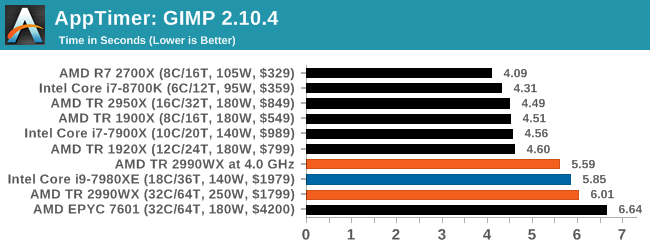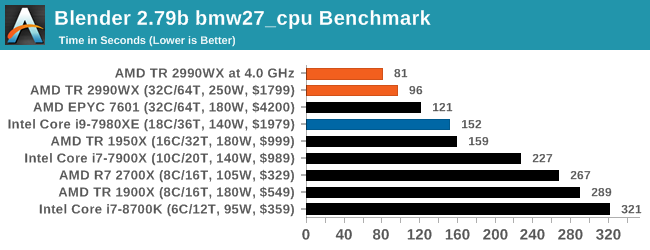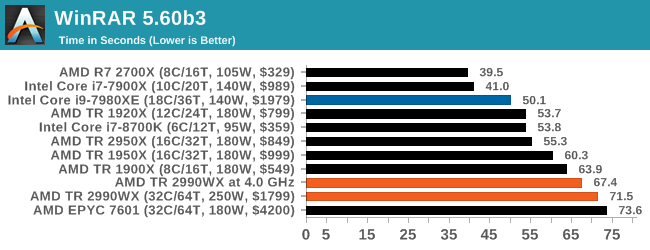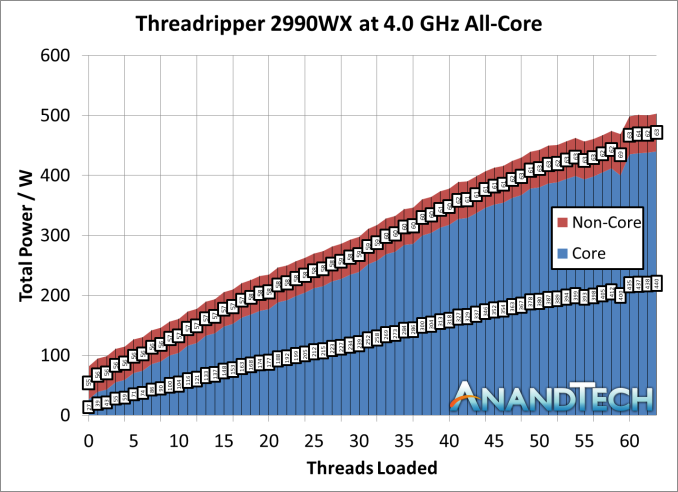The AMD Threadripper 2990WX 32-Core and 2950X 16-Core Review
by Dr. Ian Cutress on August 13, 2018 9:00 AM ESTOverclocking: 4.0 GHz for 500W
Who said that a 250W processor should not be overclocked? AMD prides itself as being a processor manufacturer that offers every consumer processor as a multiplier unlocked part, as well as using a soldered thermal interface material to assist with thermal dissipation performance. This 2990WX has an X in the same, so let the overclocking begin!
Actually, confession time. We did not have much time to do overclocking by any stretch. This processor has a 3.0 GHz base frequency and a 4.2 GHz turbo frequency, and in an air-conditioned room using the 500W Enermax Liqtech cooler, when running all cores under POV-Ray, we observed each core running around 3150 MHz, which is barely above the turbo frequency. The first thing I did was set the all-core turbo to 4.2 GHz, the same as the single core turbo frequency. That was a bust.
However, the next stage of my overclocking escapades surprised me. I set the CPU to a 40x multiplier in the BIOS, for 4.0 GHz on all the cores, all the time. I did not adjust the voltage, it was kept at auto, and I was leaving the ASUS motherboard to figure it out. Lo and behold, it performed flawlessly through our testing suite at 4.0 GHz. I was shocked.
All I did for this overclock was turn a setting from ‘auto’ to ‘40’, and it breezed through almost every test I threw at it. I say almost every test – our Prime95 power testing failed. But our POV-Ray power testing, which draws more power, worked. Every benchmark in the suite worked. Thermals were high (in the 70s), but the cooler could take it, and with good reason too.
At full load in our POV-Ray test, the processor was listed as consuming 500W. The cooler is rated for 500W. At one point we saw 511W. This was split between 440W for the cores (or 13.8W per core) and 63W for the non-core (IF, IO, IMC) which equates to only 12.5% of the full power consumption. It answers the question from our Infinity Fabric power page - if you want the interconnect to be less of the overall power draw, overclock!
We also tried 4.1 GHz, and that seemed to work as well, although we did not get a full benchmark run out of it before having to pack the system up. As stated above, 4.2 GHz was a no-go, even when increasing the voltage. With tweaking (and the right cooling), it could be possible. For anyone wanting to push here, chilled water might be the way to go.
Performance at 4.0 GHz
So if the all-core frequency was 3125 MHz, an overclock to 4000 MHz all-core should give a 28% performance increase, right? Here are some of the key tests from our suite.






Overclocking the 2990WX is a mixed bag, because of how it does really well in some tests, and how it still sits behind the 2950X in others due to the bi-modal nature of the cores. In the tests were it already wins, it pushes out a lot more: Blender is up 19% in throughput, POV-Ray is up 19%, 3DPM is up 19%. The other tests, is catches back up to the 2950X (Photoscan), or still lags behind (app loading, WinRAR).
Overclocking is not the cure-all for the performance issues on the 2990WX, but it certainly does help.











171 Comments
View All Comments
sjoukew - Thursday, August 16, 2018 - link
There is also an article which shows the difference in performance on windows vs linux for the Threadripper processors. It is amazing to see. https://www.phoronix.com/scan.php?page=article&...ishould - Monday, August 13, 2018 - link
TLDR; Unless you have a very specific need for 32 cores/2990WX, the 2950x is faster and cheaper than the former, even during tasks that traditionally scale well with cores. This is looking to be a good differentiator between Zen+ EPYC and 2990WX. Definitely looking forward to Zen+ EPYC tests!Silma - Monday, August 13, 2018 - link
"... it makes perfect sense for a narrow set of workloads where it toasts the competition."Can you please list those workloads?
When would it make sense to purchase a Threadripper PC vs many 'normal processors' PCs for tasks that you can easily handle in parallel?
Aephe - Monday, August 13, 2018 - link
For example people like me who use their computers for 3D rendering for one. (again: those Corona scores!) The more cores (and Ghz) + ram, the better!jospoortvliet - Saturday, August 18, 2018 - link
And linux/Unix use, like C++ or Rust developer. Or heavy vm user. https://www.phoronix.com/scan.php?page=article&...beggerking@yahoo.com - Monday, August 13, 2018 - link
I'm so glad the competition is back! its been stagnant for years now (at about 4 cores) with Intel dominating the market. For home labs/servers, this is great news! more cores for less without having to go the Xeon ES routes. :)j1ceasar@yahoo.com - Monday, August 13, 2018 - link
Can some one tell me who needs these, i don't as a normal consumercheshirster - Monday, August 13, 2018 - link
"tell me who needs these"As a normal customer you don't need to know this.
Gothmoth - Monday, August 13, 2018 - link
sorry but this handbrake numbers look wrong. no other website i have visited has seen such big differences.twtech - Monday, August 13, 2018 - link
I really would like to see some code compile benchmarks. Next to rendering and other graphic content related tasks, compiling code in large codebases is probably the 2nd most common use-case someone would consider buying a processor like this for, and it seems like there is a dearth of coverage for it.